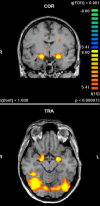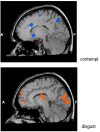Sex differences in neural activation to facial expressions denoting contempt and disgust
- PMID: 18985147
- PMCID: PMC2572192
- DOI: 10.1371/journal.pone.0003622
Sex differences in neural activation to facial expressions denoting contempt and disgust
Abstract
The facial expression of contempt has been regarded to communicate feelings of moral superiority. Contempt is an emotion that is closely related to disgust, but in contrast to disgust, contempt is inherently interpersonal and hierarchical. The aim of this study was twofold. First, to investigate the hypothesis of preferential amygdala responses to contempt expressions versus disgust. Second, to investigate whether, at a neural level, men would respond stronger to biological signals of interpersonal superiority (e.g., contempt) than women. We performed an experiment using functional magnetic resonance imaging (fMRI), in which participants watched facial expressions of contempt and disgust in addition to neutral expressions. The faces were presented as distractors in an oddball task in which participants had to react to one target face. Facial expressions of contempt and disgust activated a network of brain regions, including prefrontal areas (superior, middle and medial prefrontal gyrus), anterior cingulate, insula, amygdala, parietal cortex, fusiform gyrus, occipital cortex, putamen and thalamus. Contemptuous faces did not elicit stronger amygdala activation than did disgusted expressions. To limit the number of statistical comparisons, we confined our analyses of sex differences to the frontal and temporal lobes. Men displayed stronger brain activation than women to facial expressions of contempt in the medial frontal gyrus, inferior frontal gyrus, and superior temporal gyrus. Conversely, women showed stronger neural responses than men to facial expressions of disgust. In addition, the effect of stimulus sex differed for men versus women. Specifically, women showed stronger responses to male contemptuous faces (as compared to female expressions), in the insula and middle frontal gyrus. Contempt has been conceptualized as signaling perceived moral violations of social hierarchy, whereas disgust would signal violations of physical purity. Thus, our results suggest a neural basis for sex differences in moral sensitivity regarding hierarchy on the one hand and physical purity on the other.
Conflict of interest statement
Figures




References
-
- Rozin P, Lowery L, Imada S, Haidt J. The CAD triad hypothesis: A mapping between three moral emotions (contempt, anger, disgust) and three moral codes (community, autonomy, divinity). J Pers Soc Psychol. 1999;76:574–586. - PubMed
-
- Schweder RJ, Much NC, Mahapatra M, Park L. The “Big Three” of morality (autonomy, community, divinity), and the “Big Three” explanations of suffering. New York: Routledge; 1997.
-
- Haidt J. The moral emotions. In: Davidson RJ, Scherer KR, Hill Goldsmith H, editors. Handbook of affective sciences. Oxford: Oxford University Press; 2002. pp. 852–871.
-
- Ekman P. Emotions revealed. New York: Times Books; 2003.
-
- Matsumoto D, Ekman P. The relationship among expressions, labels, and descriptions of contempt. J Pers Soc Psychol. 2004;87:529–540. - PubMed
Publication types
MeSH terms
LinkOut - more resources
Full Text Sources

